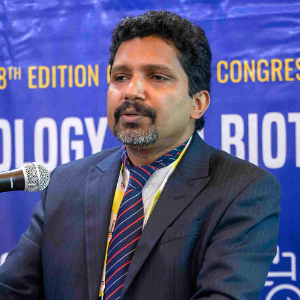Srinivasa Rao Mentreddy, Alabama A&M University, United States
Turmeric (Curcuma spp.), used in Indian medicine for over 4000 years, is now gaining popularity in the US as a health supplement to combat inflammatory diseases, memory loss, and immune deficiency, among many others. A lack of high curcumin turmeric varieties adapted to the south [....] » Read More




































Title : Techniques for identification and managing bacterial and fungal diseases of tomatoes
Mohammad Babadoost, University of Illinois, United States
Illinois is an important state in producing fresh-market tomatoes in the United States. In this state, tomatoes are produced in open-fields and indoors (greenhouses and high tunnels). Weather conditions in Illinois are conducive for developing biotic and abiotic diseases. Several [....] » Read More
Title : Mineralisation of urban waste through composting in agriculture in a circular economy
Mary Cole, The University of Melbourne, Australia
Australians are looking to recycle organic streams by composting to keep these valuable materials away from landfill. Worldwide, communities are addressing recycling of solids and green organics as cities increase in size and landfill sites become less available. The alkaline nat [....] » Read More
Title : Evaluation of three tomato varieties (Solanum lycopersicum L.) inoculated with bacteria under stress conditions induced by wastewater and copper sulfate
Abdul Khalil Gardezi, Colegio de Posgraduados, Mexico
The objective of this study was to evaluate the responses of three tomato varieties (Solanum lycopersicum L.) inoculated with bacterial strains under stress conditions induced by wastewater and copper sulfate in a greenhouse environment at the Postgraduate Campus Montecillo, Texc [....] » Read More
Title : LATscan: Expanding horizons in plant biology with laser ablation tomography
Benjamin Hall, Founder - L4IS, LLC, United States
Laser Ablation Tomography (LATscan) represents a revolutionary advancement in three-dimensional imaging and analysis of biological tissues, offering unprecedented precision and efficiency. Within the realm of plant biology, LATscan has proven instrumental in addressing critical c [....] » Read More
Title : Real-time in-situ monitoring of environmental stress in aquatic plants by dissolved oxygen-quenched fluorescence/materials movement-induced beam deflection
Xing Zheng Wu, Fukuoka Institute of Technology, Japan
We report a novel optical detection system that allows for real-time in-situ monitoring of environmental stress such as heavy metal stress in aquatic plants by making use of the dissolved oxygen-quenched fluorescence and material movements-induced beam deflection. A blue semicond [....] » Read More
Title : Plants with microbial fuel cells for green energy production, green sustainable remediation, and net zero emissions
Chung Yu Guan, National Taiwan University, Taiwan
The excessive use of fossil fuels increases greenhouse gas concentrations, leading to the greenhouse effect and climate change. Human activities also contribute to environmental pollution, including soil and water contamination. Plant-Microbial Fuel Cells (PMFCs) are an emerging [....] » Read More
Title : Algal collections in the green era
Maya P. Stoyneva-Gaertner, Sofia University St. Kliment Ohridski, Bulgaria
The challenges of climate change and adaptation to this change, the increasing scarcity and depletion of natural resources and the resilience to pressures resulting from the disruption of ecosystems have forced governments and international organisations to move from traditional [....] » Read More
Title : The rhodopean silivryak (Haberlea rhodopensis), the "resurrection plant" or the flower of orpheus
Nedyalka Valcheva, Vocational High School, Bulgaria
The Rhodopean silivryak (Haberlea rhodopensis or Rhodopean haberlea) is a representative of the Gesneriaceae family. It is a Balkan endemic, a protected relict species. It is known for its long-term anabiotic drought resistance, also known as the “resurrection plant” [....] » Read More
Title : Biotechnological potential of aeroterrestrial algae from the Algal Collection of Sofia University (ACUS)
Blagoy Uzunov, Sofia University St. Kliment Ohridski, Bulgaria
The living algal collection (ACUS) of Sofia University St. Kliment Ohridski (Bulgaria) has been the most important centre and custodian of aeroterrestrial algal biodiversity in Bulgaria since its establishment in 2006. Its mission is fulfilled through systematic research, pioneer [....] » Read More
Title : Reinforcement of alginate beads of microalgal-bacterial immobilized consortia with cellulose nanofibers for aquaculture wastewater treatment
Teresita Marzialetti Bernardi, University of Concepcion, Chile
The increasing demand for sustainable wastewater management has driven the development of innovative solutions integrating biological and nanotechnological approaches. This study focuses on enhancing the mechanical and functional properties of alginate beads for microalgal-bacter [....] » Read More
Title : Synthesis of hydrogels with controlled nutrient release utilizing fishery industry waste
Luis Felipe Montoya Rendon, University of Concepcion, Chile
Water scarcity and soil degradation are global problems that directly affect agricultural productivity. Conventional agriculture, characterized by inefficient water use and high dependence on chemical fertilizers, exacerbates these problems. This research aims to reverse this tre [....] » Read More
Title : Diversity in the genus Geranium from Pangi Valley, an unexplored trans Himalayan region along with new records for Himachal Pradesh, Western Himalaya, India
Poushali Dey, CSIR-National Botanical Research Institute, India
Introduction: The genus Geranium L. belongs to the tribe Geranieae Benth. of the family Geraniaceae and comprises ca. 430 species distributed in tropical, temperate and alpine regions of the world. The first systematic account of the Indian Geranium is available in “Flora o [....] » Read More
Title : Ri technology: A Non-GMO approach to enhancing plant stress tolerance
Chen Ge, University of Copenhagen, Denmark
Rhizobium rhizogenes is a plant bacterium that carries a plasmid containing the root inducing (Ri) genes. These Ri genes can be inserted into the plant host’s genome and induce hairy root formation. The integration process, called horizontal gene transfer (HGT), has been ex [....] » Read More
Title : Ri technology: A Non-GMO approach to enhancing plant stress tolerance
Linda Hoegfeldt, University of Copenhagen, Denmark
Rhizobium rhizogenes is a plant bacterium that carries a plasmid containing the root inducing (Ri) genes. These Ri genes can be inserted into the plant host’s genome and induce hairy root formation. The integration process, called horizontal gene transfer (HGT), has been ex [....] » Read More
Title : Exploring rooting systems of Ri-naturally transformed Oilseed rape (Brassica napus)
Juan Jose Rodriguez Fuentes, University of Copenhagen, Denmark
Natural transformation involves the genetic modification of plants using wild strains of e.g. Rhizobium rhizogenes. This technique has emerged as a valuable biotechnological breeding method through the insertion of the root-inducing (Ri) genes, which can introduce desirable trait [....] » Read More
Title : Iron deficiency in rice under alkaline conditions is induced by the suppression of iron uptake mechanisms and iron transport responses
Tomoki Okamura, Toyo University, Japan
Under current environmental conditions on Earth, iron (Fe) is readily oxidized from its divalent form (Fe²?) to its trivalent form (Fe³?). It predominantly exists in soil as ferric hydroxide (Fe(OH)?), which is highly insoluble in water. This insolubilization is particu [....] » Read More
Title : Rooftop vertical aquaponics systems for sustainable urban farming
Khin Mar Cho, Temasek Polytechnic, Singapore
Unlike traditional farming, an urban farming is the practice of cultivating crops either in indoor or outdoor spaces of the buildings. It refers to the farming activities in urban areas, which are commonly used for income or food. The rooftop vertical farming helps to overcome li [....] » Read More